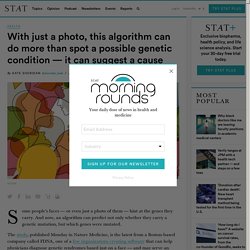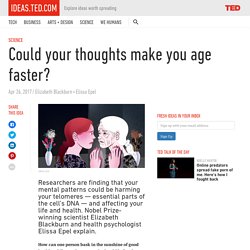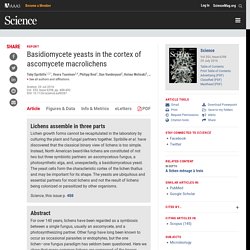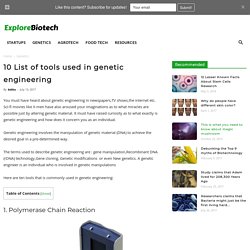

How our cells repair their damaged DNA. Researchers have found a key mechanism by which cells can repair their own damaged DNA.

The new results have implications for developing new, preventative cancer treatments. (Photo: Shutterstock) New research shows that some previously overlooked molecules in the body's cells play a key role in the repair of damaged DNA. The neglected molecule is called histone 1 (H1), and has so far mainly been described as a molecule that helps to organise DNA within cells.
But a new study suggests that H1 also plays an important role in DNA repair. The new discovery, according to the scientists behind the new results, could lead us towards a better understanding of how cancer develops in the first place. "Cancer is characterised as a disease that causes damage to the DNA. A View of Cellular Emergency Repair Mechanisms. DNA proofreading and repair (article) [quant-ph/0002037] Quantum Algorithms and the Genetic Code. Your Genes Don't Fit: Why 10,000 Hours of Practice Won't Make You an Expert. Book excerpt by Temple Grandin and Richard Panek In recent years, the relationship between nature and nurture has been getting a lot of attention in the popular press. Changing Our DNA through Mind Control? “I think, therefore I am” is perhaps the most familiar one-liner in western philosophy.

Even if the stoners, philosophers and quantum mechanically-inclined skeptics who believe we’re living an illusion are right, few existential quips hit with such profound, approachable simplicity. The only catch is that in Descartes’ opinion, “we” – our thoughts, our personalities, our “minds” – are mostly divorced from our bodies. The polymathic Frenchman and other dualist philosophers proposed that while the mind exerts control over our physical interaction with the world, there is a clear delineation between body and mind; that our material forms are simply temporary housing for our immaterial souls. But centuries of science argue against a corporeal crash pad. The body and mind appear inextricably linked. Lead investigator Dr. In Carlson’s study distressed breast cancer survivors were divided into three groups.
New study shows AI can diagnose some gene mutations from a photo. Some people’s faces — or even just a photo of them — hint at the genes they carry.

And now, an algorithm can predict not only whether they carry a genetic mutation, but which genes were mutated. Could these five thought patterns be making you age faster? Jenn Liv How can one person bask in the sunshine of good health, while another person looks old before her time?

Humans have been asking this question for millennia, and recently, it’s becoming clearer and clearer to scientists that the differences between people’s rates of aging lie in the complex interactions among genes, social relationships, environments and lifestyles. Even though you are born with a particular set of genes, the way you live can influence how they express themselves. Some lifestyle factors may even turn genes on or shut them off. Deep within the genetic heart of all our cells are telomeres, or repeating segments of noncoding DNA that live at the ends of the chromosomes. How a Guy From a Montana Trailer Park Overturned 150 Years of Biology. You’ve seen lichens before, but unlike Spribille, you may have ignored them.

Basidiomycete yeasts in the cortex of ascomycete macrolichens. Lichens assemble in three parts Lichen growth forms cannot be recapitulated in the laboratory by culturing the plant and fungal partners together.

Spribille et al. have discovered that the classical binary view of lichens is too simple. Instead, North American beard-like lichens are constituted of not two but three symbiotic partners: an ascomycetous fungus, a photosynthetic alga, and, unexpectedly, a basidiomycetous yeast. The yeast cells form the characteristic cortex of the lichen thallus and may be important for its shape. The yeasts are ubiquitous and essential partners for most lichens and not the result of lichens being colonized or parasitized by other organisms. Science, this issue p. 488 Abstract. A Brief Guide to Genomics.
Virtually every human ailment has some basis in our genes.

Until recently, doctors were able to take the study of genes, or genetics, into consideration only in cases of birth defects and a limited set of other diseases. These were conditions, such as sickle cell anemia, which have very simple, predictable inheritance patterns because each is caused by a change in a single gene. With the vast trove of data about human DNA generated by the Human Genome Project and other genomic research, scientists and clinicians have more powerful tools to study the role that multiple genetic factors acting together and with the environment play in much more complex diseases.
These diseases, such as cancer, diabetes, and cardiovascular disease constitute the majority of health problems in the United States. Genetic Literacy Project. White House Launches The National Microbiome Initiative. 10 List of tools used in genetic engineering. You must have heard about genetic engineering in newspapers,TV shows,the internet etc.

Sci-fi movies like X-men have also aroused your imaginations as to what miracles are possible just by altering genetic material. It must have raised curiosity as to what exactly is genetic engineering and how does it concern you as an individual. Genetic engineering involves the manipulation of genetic material (DNA) to achieve the desired goal in a pre-determined way. The terms used to describe genetic engineering are : gene manipulation,Recombinant DNA (rDNA) technology,Gene cloning, Genetic modifications or even New genetics. A genetic engineer is an individual who is involved in genetic manipulations Here are ten tools that is commonly used in genetic engineering:
Use green fluorescent protein to tag expression of genes. Viewables. DNA from the Beginning - An animated primer of 75 experiments that made modern genetics. BioMed. Data Bowl. Futuresque. Health Anomalies. Health Research. Health Sensitivities.
Energy Matters. Physics Bowl. Labs Researchers. SCIENCE Breakthroughs. DNA. Genomic Insights.